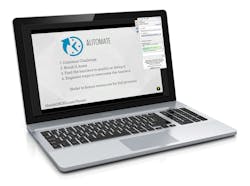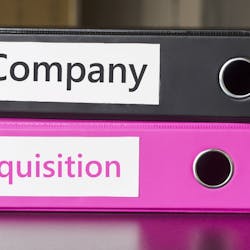The idea of creating and conducting a webinar can be a somewhat intimidating proposition. (In fact, I’m about to launch a series of digital and social media marketing webinars in conjunction with NAMA, and the thought of doing them makes me perspire a little…but only just a little, because I know for a fact that they provide value.)
As an online marketing opportunity, the benefits of webinars are significant. They can allow you to reach dozens of prospects at one time — not one at a time — and they can reinforce your authority leadership position in vending, OCS and/or micro markets among your existing customers and prospects. (Probably best to pick one of the three areas and not try to tackle too much in one webinar.) A good webinar enables you to promote your products and services while you are educating its attendees, and you can make an offer at the end that ensures those who attend end up in your sales lead generation funnel.
If you think webinars could be a great online marketing tool for your business, begin by asking yourself the following questions:
- What is my “big idea” or a topic about which I am an expert?
- Why should attendees care about my webinar?
- What is the “secret sauce” that inspires my customers to take action?
- What are some secondary motivators for them?
- What will I teach through my content?
- What will my ultimate call-to-action be?
There are essentially five steps to creating and conducting an effective marketing or sales webinar. They are:
- Initial Attraction
- Indoctrination
- Execution & Content (both educational and promotional!)
- “The Offer”
- Follow Up
Before we jump into the steps, it’s important to stress that a webinar does NOT require its host to be “on camera.” Many, many successful webinars are conducted every day with a PowerPoint deck, some great content, and even a script. Yep, you can write your webinar content out — word for word — and deliver it from the script. Just be sure to rehearse it once or twice beforehand.
As you become more confident, you might want to try some where your customers and prospects can see your face — perhaps during the opening and closing — which will reinforce your expertise, thought leadership and winning personality in their minds. Doing so can greatly enhance your lead conversion rates.
Initial Attraction
The first step, attraction, is a numbers game. You want to get the word out to as many people as you can — with the topic, the date, the time, format, how to sign up, and any other details you believe are important. If you have a CRM tool like Infusionsoft, you can send out invitation emails to your database and then “auto-responder” emails when someone signs up, then reminders — and possibly a second round of reminders closer to the date.
But you can also post about it on LinkedIn, place an ad on Facebook or Twitter, and send messages to all of your connections and friends on all of your social media platforms.
Decide before you begin promoting the webinar if you want it to be a “Leads & Appointments” webinar or a “Sales” webinar. If you’re going to be actively selling products and services during the webinar, make sure you have educated the attendees on the topic before you jump into your sales pitch. And, make sure you have an e-commerce solution in place that enables attendees to make a deposit or pay your “special pricing for attendees,” etc. The simplest e-commerce solution, if you don’t have one, is PayPal, but there are many others to choose from.
Indoctrination
This is the period between your initial attraction announcement and the day the webinar takes place. It’s important because it “warms up” your targets to the topic and the host, it enables you to begin a new relationship or reinforce an existing relationship with the attendee(s), agitate the pain point (namely what is the problem or issue you’ll be addressing and the solutions you can offer), and pre-educate, if need be, on information your attendees may not possess but it would improve their experience if they did. And, you can begin to hint at the offer you will make during the webinar, so they think they’re going to get more than just a “good lecture” if they attend.
As you’re indoctrinating, make sure that your title identifies the right attendee, explains a primary benefit of attending, how that benefit will be achieved and addresses an objection they may have to your content or subject matter. For instance, a webinar title using that formula could be: “How Human Resource Managers (attendees) Can Increase Employee Productivity (benefit) through a Coffee House Experience in the Break Room (how it’s achieved) without Costing a Small Fortune (a possible objection).”
And certainly, be sure to build out the content of the webinar to deliver on the title you will have so carefully crafted. There’s nothing worse than a webinar that promotes one topic, but rambles or wanders into many others that aren’t relevant.
Execution & Content
As you begin to use webinars as a lead gen tool or just a great marketing/positioning tool, your attendance expectations should be low. Don’t be disappointed if only 25 percent of those who signed up actually attend. If you are consistent in using webinars as a way to market your business online, your numbers will improve. But don’t ever expect more than 80 percent of those who registered to ever show up.
To improve your numbers, make sure you have reminded them of the day and time more than once during Indoctrination; remind them why it’s so important they attend; and reinforce that those who attend will receive a special offer at the end (this also helps ensure that attendees stay through the entire webinar).
Make sure the webinar content is truly educating attendees about topics that matter to them. You can promote your products and services, but be sure to do so in the context of education, even if your goal is sales and not just lead gen or appointments!
As a beginner, keep the webinar short and advertise it that way (because we’re all busy people, right?). For instance, you could call it “The 20 Minute Executive Briefing on [insert your topic].”
If you’re going to have 5-10 min of live Q&A at the end (which you might want to work your way up to…your first few webinars might just focus on delivering content with no Q&A), make sure you have a moderator who can be watching the comments and questions box and be selecting the best questions for you to answer or the best comments to share at the end. Using a product like Citrix GoToWebinar makes the process easy, but it does cost a few bucks to buy the Citrix system. The moderator can also directly answer questions that you and the moderator don’t believe are relevant to the entire group of attendees, or handle questions/comments that are off topic while you’re delivering the content.
You can also use the execution of your webinar to “seed” upcoming content, either about additional upcoming webinars, or content you will be posting on your website, blog or other online locations where you’re actively promoting your business.
And like any good PowerPoint presentation or slide deck, be sure that you switch up the format of your slides — some with colorful, appealing bullet-pointed material, some with only a compelling visual that reinforces a point you’re making verbally, and some that have both content and visuals. Try to make the slides light on copy; after all, you will be delivering the majority of the content verbally (from your script if you choose to use one).
“The Offer”
At the end, offer some bonus content such as a “Tip Sheet On Healthy Vending” or an online guide about “How To Pick The Best Products For Your Micro Market,” for instance. In order for the attendees to receive the bonus content, direct them to a URL on your website or a landing page you may have created to highlight key content points and to redeem that special offer by opting in with their name, email address and possibly a phone number. (Keep in mind that a complicated opt-in form can drive people away.)
For it to be meaningful, your offer has to be appealing to your attendees. You can create the content, or you can curate the content of the offer — such as a third-party expert who has given you his/her permission to “borrow” their content because it’s good for you and good for them.
Ultimately, it’s about driving attendees to take action, so have a call-to-action at the end of your webinar, such as “Go to [URL] to learn more about...” or “Take advantage of our special offer by pasting this simple link into your browser today! You’ll be glad you did!” And if your URL is long and complicated looking, remember that you can always shorten it by going to https://bitly.com/ — it’s a fantastic tool to shorten a URL so your attendees don’t miss your offer by typing the wrong URL into their browsers. Bit.ly URLs work really well in Twitter posts, too!
Follow Up
Conducting a webinar and all it entails, creating your “offer,” promoting and indoctrinating potential attendees will be for naught if you don’t follow up immediately after the webinar has concluded.
The most important aspect of follow up is having it all thought through and planned out before you even launch your initial attraction campaign.
The first step is to “park” the webinar content on your website or a landing page, which should be recorded through the Citrix technology, and let it just auto-play anytime someone who couldn’t attend the live webinar wants to view it at a time most convenient for them. Tip: Be sure to delete the Q&A from the original webinar because it obviously won’t make sense — Citrix can help with that.
Most successful online marketers follow up their webinars with an email campaign that relates to the subject matter, but moves the customer or prospect to the “next level,” whatever that may be for your business. What’s the next product you can sell them? What’s the next topic on which they need to be educated? They may not buy what you’re selling or sign up for the very next webinar, but that just means you will need to nurture them along like any of your prospects until they are ready to move to the next level.
Finally, put your webinar(s) on a timeline, or they will never happen. Like everything in our businesses, we have to commit and then follow through. Here’s a simple milestone-based timeline you can use in planning your first (or next) webinar:
Milestone Due Date
□ Outline completed _____________________________
□ Script drafted _____________________________
□ PowerPoint/Keynote created _____________________________
□ Revisions to script & slides completed ______________________________
□ Registration page live ______________________________
□ Rehearsal completed ______________________________
□ Citrix (or similar) tech all set up ______________________________
□ Webinar set to be recorded for auto-play ______________________________
□ Webinar goes live! ______________________________
Plan your first (or next) webinar with the simple milestone-based timeline above. And don’t forget to make the webinar process and the webinar itself fun.
Updated About the Auhtor:
John Healy is CEO of Healy Consulting & Communications Inc., a traditional, digital and social media marketing firm that strives to ensure its clients’ relevance while fueling their growth and success. He can be reached at [email protected].





